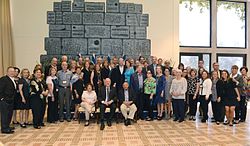Jewish Federations of North America
 | |
| Abbreviation | JFNA |
|---|---|
| Formation | January 31, 1935[1] |
| Legal status | 501(c)(3) nonprofit organization |
| Headquarters | New York City |
Region | North America |
President and CEO | Eric D. Fingerhut[2] |
Chair of the board | Mark Wilf[2] |
| Subsidiaries | |
Revenue (2012) | US$49.0 million[3] |
| Expenses (2012) | US$49.2 million[3] |
| Endowment (2012) | US$26.1 million[3] |
Employees (2012) | 144[3] |
Volunteers (2012) | 185[3] |
| Website | jewishfederations |
Formerly called | |

The Jewish Federations of North America (JFNA), formerly the United Jewish Communities (UJC),[4] is an American Jewish umbrella organization representing 146 Jewish Federations and 300 independent Jewish communities across North America, which raise and distribute more than $3 billion annually and through planned giving and endowment programs to support social welfare, social services and educational needs. JFNA also provides fundraising, organization assistance, training, and overall leadership to the Jewish Federations and communities throughout the United States and Canada. The Federation movement protects and enhances the well-being of Jews worldwide through the values of tikkun olam, tzedakah and Torah.[5]
JFNA was formed from the merger of the United Jewish Appeal (UJA), Council of Jewish Federations, and the United Israel Appeal.
History[]
Council of Jewish Federations[]
The original umbrella organization for the federations was the National Council of Jewish Federations and Welfare Funds formed in 1932.[6][7] "National" was dropped from the name in 1935 and "Welfare Funds" was removed in 1979.[6]
Jewish Federations of North America[]
In 1999, the CJF merged with the United Jewish Appeal to become the United Jewish Communities.[6] In October 2009, the UJC was renamed the Jewish Federations of North America.[8]
After the 2009 launch of the new logo for The Jewish Federations of North America, increasing numbers of local Federations are switching to some variant of that logo. An example is the Jewish Federation of Greater Washington.[9]
After a couple of years of lower staff layoffs in February 2010, new CEO Jerry Silverman laid off three senior vice presidents that made an estimated $750,000 to $1 million combined.[10] JNFA declined to run the decennial National Jewish Population Survey in 2010 due to re-prioritizing.[11]
National Jewish Population Survey[]
The National Jewish Population Survey (NJPS) was a decennial survey run by JFNA as a census of the Jewish community in the United States. The NJPS has been controversial at times. The 1990 survey indicated that inter-faith marriage was occurring at a rate of 52 percent which was quickly denounced by demographers. With the NJPS 2000-01, a number of problems plagued the survey as it used a different method than the 1990 thus not comparable, cost $6 million and the data was lost. JFNA would not fund the 2010 survey due to re-prioritizing given decreased revenue given its limited direct benefits with some Jewish federations like the New York federation. JFNA was then open to partnering with other agencies on the national survey.[11]
References[]
- ^ Jump up to: a b c "The Jewish Federations of North America, Inc." Division of Corporations, State Records, and UCC. State of New York. Accessed on December 31, 2015.
- ^ Jump up to: a b Carroll, Ed (16 May 2019). "Eric Fingerhut leaves top post at Hillel to head Jewish Federations of North America". Jewish Telegraphic Agency. Retrieved 25 May 2020.
- ^ Jump up to: a b c d e f g h "Form 990: Return of Organization Exempt from Income Tax". Jewish Federations of North America Inc. Guidestar. June 30, 2013.
- ^ Berkman, Jakob (June 9, 2009). "UJC to Change Name". Jewish Telegraphic Agency. Retrieved 2016-12-31.
- ^ "About JFNA". JFNA. Retrieved 25 May 2020.
- ^ Jump up to: a b c Karesh, Sara E.; Hurvitz, Mitchell M. (2006). "United Jewish Communities". In Melton, J. Gordon (ed.). Encyclopedia of Judaism. Infobase Publishing. pp. 534–535. ISBN 978-0-8160-5457-2. Retrieved June 14, 2011.
In 1932 the National Council of Jewish Federations and Welfare Funds (NCJFWF) united the Jewish federations across the country. In 1935 the organization changed its name to the Council of Jewish Federations and Welfare Funds (CJFWF), and in 1979 the name became the Council of Jewish Federations (CJF). [...] In 1999, the United Jewish Appeal and the Council of Jewish Federations merged to become the United Jewish Communities.
- ^ Elazar, Daniel Judah (1995) [1976]. Community and polity:the organizational dynamics of American Jewry. Jewish Publication Society. p. 413. ISBN 978-0-8276-0565-7. Retrieved June 14, 2011.
This new phenomenon was incorporated into campaign strategy, particularly through "Super Sunday," a day-long happening featuring marches on behalf of some special financial need and massive telephoning of potential donors in a more exciting carnival-like atmosphere.
- ^ Elliott, Stuart (May 17, 2010). "You Don't Have to Be Jewish to Love This Campaign". New York Times. Retrieved June 14, 2011.
...the Jewish Federations, which changed its name in October from the United Jewish Communities.
- ^ "Jewish Federation of Greater Washington adaptation of JFNA logo". The Jewish Federations of North America. Archived from the original on January 11, 2010. Retrieved January 5, 2010.
- ^ Berkman, Jacob (February 23, 2010). "Inside the top-level layoffs at Jewish Federations of North America". Jewish Telegraphic Agency. Retrieved January 6, 2016.
- ^ Jump up to: a b Heilman, Uriel (July 12, 2011). "Is the era of national surveys of American Jews at an end?". Jewish Telegraphic Agency. Retrieved January 6, 2016.
External links[]
- Jewish Federations of North America
- Jewish-American political organizations
- Jewish community organizations
- Jewish Agency for Israel
- Philanthropic organizations based in the United States
- 501(c)(3) organizations
- Non-profit organizations based in New York City
